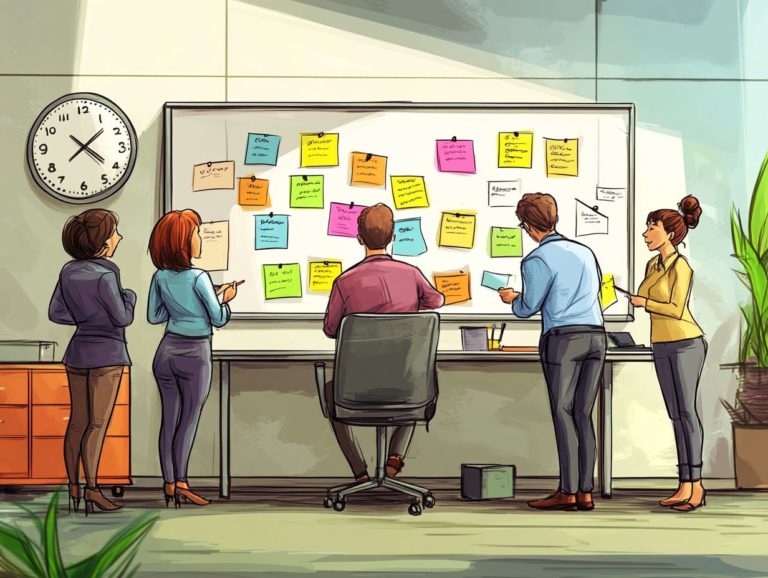3 Simple Steps to Master Task Prioritization
In today s fast-paced world, juggling multiple responsibilities can feel utterly overwhelming. Task prioritization isn t just a buzzword; it s an essential skill for boosting your productivity and achieving your goals.
This guide will lead you through three straightforward steps to master the art of task prioritization. You ll discover how to identify and list all your tasks, evaluate and rank them effectively, and create a plan that keeps you laser-focused. You ll also find useful tips to help you stay on track.
Ready to take control of your to-do list? Let s dive in now!
Contents
- Key Takeaways:
- The Importance of Task Prioritization
- Step 1: Identify and List All Tasks
- Step 2: Evaluate and Rank Tasks
- Step 3: Create a Plan and Stick to It
- Tips for Maintaining Task Prioritization
- Strategies for Staying on Top of Priorities
- Frequently Asked Questions
- What is task prioritization?
- Why is task prioritization important?
- What are the 3 simple steps to master task prioritization?
- How can I identify the importance of a task?
- What if I have too many important tasks and can’t prioritize them?
- Is it important to regularly review and adjust task prioritization?
Key Takeaways:

- Prioritizing tasks is crucial for increasing productivity and achieving goals.
- A comprehensive task list is the first step in effective task prioritization.
- Evaluating and ranking tasks based on importance, urgency, and resources can help create a solid plan for optimal productivity.
The Importance of Task Prioritization
Task prioritization is a cornerstone of productivity, profoundly influencing how you and your team manage workloads. By learning to prioritize, you ensure that critical tasks are completed efficiently and deadlines are consistently met.
By mastering the art of prioritizing tasks, you can foster enhanced team collaboration, streamline project management, and allocate resources with precision. Learning how to create a priority list in 3 steps is essential for achieving your business goals and ensuring customer satisfaction.
Consider utilizing methods like the Eisenhower Matrix, a tool that helps you decide on and prioritize tasks by urgency and importance, or the ABCDE method. For more insights, you can explore key techniques for setting priorities. These structured approaches will help you categorize tasks effectively, paving the way for better workflow and elevating your personal productivity to new heights.
Why Prioritizing Tasks is Essential for Productivity
Prioritizing tasks is crucial for your productivity, allowing you to focus on what truly matters and ensuring that important tasks get completed efficiently. Learning how to prioritize tasks effectively can enhance your workflow even further.
By distinguishing between what demands immediate attention and what can be set aside for later, you can streamline your efforts and significantly reduce stress. This method boosts your performance and fosters a gratifying sense of accomplishment.
When the workload feels overwhelming, leveraging strategies like time chunking and the Pomodoro technique can prove especially beneficial:
- Time chunking: This encourages you to break your work into manageable segments.
- The Pomodoro technique: This promotes dedicated bursts of productivity, followed by brief, restorative breaks.
Both methods are effective in maintaining your concentration and reenergizing your mind, allowing you to tackle daily challenges with a more organized and focused approach.
Step 1: Identify and List All Tasks
The initial step in mastering task prioritization is to identify and catalog all your tasks. This lays the groundwork for effective workload management and can be enhanced by utilizing simple strategies for prioritizing tasks, fostering clear communication within your team.
By creating a comprehensive task list, you enable yourself and your colleagues to visualize responsibilities. This ensures that critical tasks are promptly recognized and addressed.
This master list should encompass both personal responsibilities and collaborative efforts, facilitating seamless task allocation and enhancing accountability throughout the team.
Creating a Comprehensive Task List

Creating a comprehensive task list is all about categorizing your tasks into actionable items. This ensures that the important ones stand out and are prioritized for execution.
To kick off this process, consider breaking your tasks into categories like urgent versus non-urgent or personal versus professional. This approach allows you to quickly identify which tasks need your immediate attention and which can be comfortably scheduled for later.
Once you have everything categorized, it s crucial to formulate action items that are specific and clear. Instead of writing something vague like “Work on report,” opt for “Draft report for Monday meeting.” This level of detail sharpens your focus and significantly enhances your productivity, making it easier to track your progress and celebrate those small victories along the way.
Step 2: Evaluate and Rank Tasks
Evaluate and rank your tasks based on urgency and importance. This helps you allocate resources effectively and meet deadlines.
Assess how each task impacts your project milestones. This allows you to focus on essential tasks and streamline your workload.
Consider using the Eisenhower Matrix (a tool for prioritizing tasks based on urgency and importance) or the ABCDE method (which categorizes tasks into five priority levels) for a structured approach to prioritization. You can also explore how to prioritize your daily tasks to enhance your productivity.
Factors to Consider When Ranking Tasks
When ranking tasks, consider their importance, urgency, and potential impact on overall productivity and deadlines. Understanding the difference between what is vital and what is merely urgent enhances your decision-making process.
Important tasks contribute meaningfully to your long-term business goals, while urgent tasks often revolve around immediate deadlines that may not align with your objectives. By recognizing how each task affects outcomes, you can prioritize more effectively.
This ensures that essential projects receive the attention they require, reducing the risk of missing critical deadlines and promoting a strategic allocation of resources. Ultimately, this approach steers your team toward success.
Step 3: Create a Plan and Stick to It
Create a strong plan for your tasks to boost efficiency and ensure timely completion. A well-organized plan involves breaking tasks into manageable segments, enhancing both focus and productivity.
Embrace techniques like the Pomodoro technique to significantly boost concentration. Clearly defined task allocation ensures that every team member is aware of their responsibilities and deadlines.
Organizing and Scheduling Tasks for Optimal Productivity

Organizing and scheduling tasks effectively is essential for achieving peak productivity. This approach allows you and your team to maintain focus and manage your time precisely.
When structured properly, these practices turn chaos into clarity, helping you prioritize responsibilities and meet critical deadlines without the stress of last-minute scrambles.
Utilizing various task management tools can elevate your organization. Digital planners, to-do lists, and project management software simplify the scheduling process, making it easier to track progress and allocate resources wisely.
To maximize productivity, break larger projects into smaller tasks, set specific time blocks for focused work, and regularly review your priorities. This strategy fosters a more efficient workflow, allowing you to work smarter, not harder.
Tips for Maintaining Task Prioritization
Maintaining effective task prioritization demands ongoing evaluation, adaptability, and the application of proven strategies. Cultivating a routine that allows for flexibility in scheduling greatly enhances focus, enabling you to tackle one task at a time.
Regularly reviewing your task lists and progress is vital. Stay ahead of deadlines and ensure your team remains aligned with overarching business goals and project milestones.
Strategies for Staying on Top of Priorities
Implementing effective strategies can greatly improve how quickly you finish tasks and boost your team’s productivity.
By prioritizing tasks and using automation to simplify repetitive processes, you free up valuable time for strategic initiatives.
Focusing on one task at a time allows for deeper engagement and higher quality of work.
Regular communication tools help your team interact seamlessly and stay aligned on objectives and deadlines.
This approach fosters accountability and boosts collective output, essential for any thriving organization.
Frequently Asked Questions
What is task prioritization?

Task prioritization means deciding which tasks are the most important to complete first. Implementing 5 ways to prioritize your daily tasks effectively helps you manage your time and resources effectively.
Why is task prioritization important?
It helps you and your team stay organized and meet deadlines while focusing on what truly matters.
What are the 3 simple steps to master task prioritization?
1) List all tasks, 2) Determine importance and urgency, 3) Prioritize based on these factors.
How can I identify the importance of a task?
Consider how a task impacts your goals and its alignment with your values.
What if I have too many important tasks and can’t prioritize them?
Use a matrix or ranking system to see which tasks are most important to tackle first.
Is it important to regularly review and adjust task prioritization?
Yes, priorities can change, so it’s crucial to reassess tasks regularly to align with your goals.






